How to cut tiles correctly?
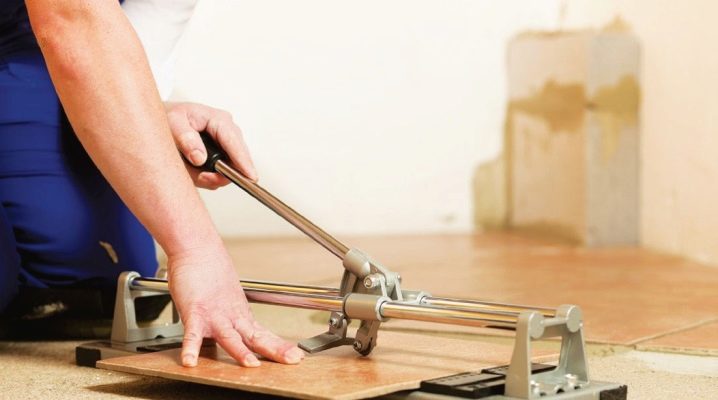
Tiles are very popular today, as they combine practicality and original design. It is made from different materials that give the element different properties. But no matter what product you decide to use, you should learn how to cut the tiles correctly. This will allow for laying with a minimum amount of material, achieving a pleasant appearance.
Peculiarities
Tile cutting is a technique that allows you to divide a single piece into several smaller pieces of various shapes. In most cases, this approach is used when the size of the tile does not match the dimensions of the room.
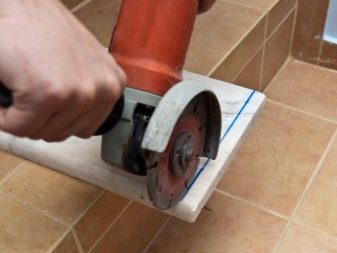

The cutting technology of this product depends on the structure of the substance from which it is made.
Conventionally, such an operation can be performed in 2 main ways:
- Incomplete cutting and breaking. In order for the tile to break, using a special tool, a small incision is formed on its surface, along which the material is broken. A similar approach is used in most cases for ceramic tiles. It is quite difficult to get a flat end on porcelain stoneware using this method, since the material is durable and solid. The deepening in this case should be at least 2/3 of the thickness of the product.
- Cutting. The process involves the complete separation of the material along a certain line. To do this, use tools that can destroy the substance without splitting the tile in half. This approach is the most practical and versatile, as it can be applied to almost any type of tile.
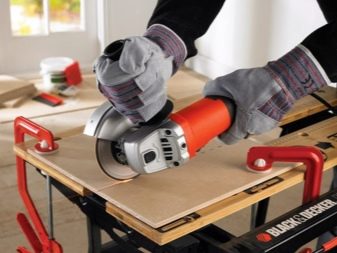

Types of tiles
Tiled materials come in different types depending on the raw materials from which they are made.
- Ceramic tile. The products are obtained by firing clay, to which various impurities are added. Depending on the composition and structure of these substances, the tile can receive strength, fragility, resistance to temperature extremes and many other characteristics. To give the material a beautiful appearance, its surface is covered with special glaze and paints. Some manufacturers give the top layer a raised texture. The material is notable for its low strength and ease of processing. It can be cut with both hand and power tools.
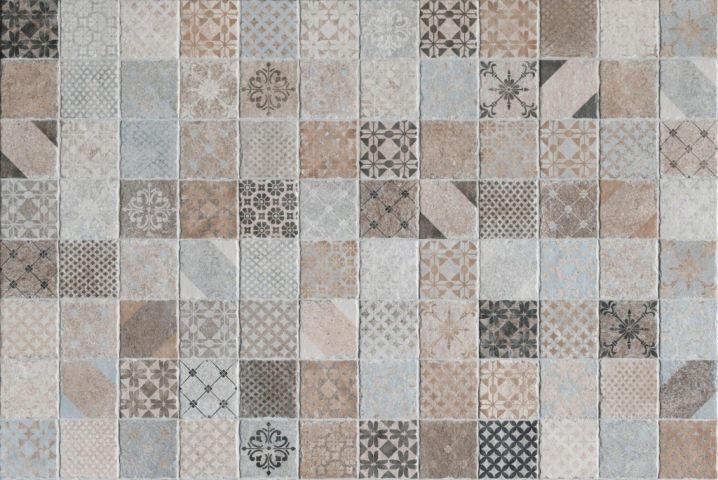
- Porcelain stoneware. Tiles of this type are characterized by high strength and solidity. This is due to the fact that it is produced under the influence of not only high temperatures, but also significant pressure. By its structure, porcelain stoneware tiles resemble natural stone, and some of their characteristics are even better than those of natural materials. Due to its high density, porcelain stoneware is difficult to cut. For such purposes, only very high-quality cutting tools are used that can destroy the monolithic structure of the stone.

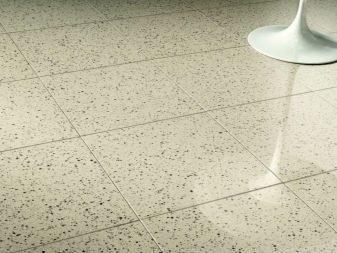
- Clinker. This type of tile also consists of clay. Manufacturing technology involves firing the mixture at very high temperatures. Clinker tiles are quite fragile, but at the same time they can withstand severe frosts, and also cannot be erased and damaged by various aggressive solutions.
- Plaster. A tile made from this substance appeared relatively recently. It is used only as a decorative element. The material is plastic and easy to process, but at the same time it absorbs moisture well. Therefore, it is better to use gypsum products only inside dry rooms with a minimum level of humidity.


What is the best way to cut?
The choice of cutting tool largely depends on the structure of the material to be processed. Today, manufacturers of finishing tiles produce several types of such tools, which differ in different technical parameters.
The facing tiles can be processed by various mechanisms. Each of them has a specific cutting precision as well as cutting quality. Therefore, it is important, before starting work with this material, to decide which tool you need to process the tiles.


Many mechanisms are not able to process the surface without chipping. Therefore, in most cases, auxiliary devices for surface grinding are also used.
Hand tools
Very often, tile processing is required at home, where there is no professional tool. In such cases, you can safely use several hand-held devices that easily cope with this task.
One of the most affordable and popular tile cutting products is the glass cutter. It should be noted right away that it can handle not very hard materials. Perfect for ceramic tiles. This is due to the fact that the product is covered on top with a kind of protective layer, which is easy to destroy with a glass cutter.

Working with this tool is quite simple and consists of several sequential operations:
- Place the tile on a flat surface before sawing. Then a cutting line is marked on the top decorative layer.
- Having placed a metal ruler along the line, it should be carried out carefully with a glass cutter, without pressing it hard into the material. After that, you need to knock lightly along the cut.
- To break off a piece correctly, place it on the edge of the table. The cutting line is aligned with the end face. Then you need to lightly press on one of the edges of the tile. Do not do this too hard or too harshly, as you may break the product in the wrong direction.

Another popular tool is the manual tile cutter. The principle of its operation is very similar to the previously described processes, but only the structure is already equipped with a special frame. Already harder types of tiles can be cut with this mechanism. A quality tool is able to cope with relatively thin porcelain stoneware.

The technology of the manual tile cutter operation consists of the following sequential actions:
- Initially, a cutting line is drawn on the surface of the tile using a pencil or marker. After that, the product is fixed in the device with special clamps. Here you need to precisely match the cutting line and the path of the blade. If this is not done, then you can get a curved element.
- To cut off a piece, the blade is pressed against the tile, and with the help of a handle, it is drawn over the material. The pressure should be moderate in order not to destroy the tile prematurely. When cutting, it is advisable to constantly monitor the position of the knife, which should move exactly along the intended line.
- Breaking the tiles is done in the same way as described in the algorithm for using a glass cutter.


If you need to remove small areas on the tiles, you can also use standard wire cutters. They do not allow you to get smooth and beautiful edges. They can be used when you need to form a hole for the water pipe, but the tile itself will be hidden.
But they will be located only on the end side of the product.


Hand tools are used in most cases for simple tasks. With their help, you can even cut out small squares or rectangles if you want to. But they will be located only on the end side of the product.
Electrical
Cutting decorative tiles very often requires speed and surface quality. In some way, this problem can be solved with the help of electrical tools.
The simplest of them is the electric glass cutter, which works almost the same as its manual counterpart. But at the same time, it allows you to achieve a better cut, which minimizes the likelihood of chips or cracks.

You can also cut tiles with an electric tile cutter. Outwardly, it resembles a small circular saw. There is a small frame along which the cutting disc moves.
The technology for working with such a tool is quite simple and involves the following sequence of actions:
- Performing markup. It is important to observe accuracy and take into account the thickness of the saw, which can take a few millimeters.
- After that, you need to start the device and slowly attach the tile to the disk. Do not jerk these parts together, as the saw entering quickly may cause the product to break. For cutting, you should slowly move the workpiece along the marked line. If the disc is placed on top of the machine, then relatively simple shapes can be cut with it.


Another cutting tool is a jigsaw. In order for it to be able to destroy ceramic tiles or porcelain stoneware, it must be equipped with a special tungsten thread. On its surface there are small-sized soldered diamonds, which, when the string moves, easily cut the material. The technology of work is practically no different from cutting ordinary wood. But experts recommend constantly monitoring the speed of the thread. If pressure is increased on it, it can tear and even injure the operator.


The jigsaw is a versatile tool, since it can be used to cut not only along a straight line, but also to obtain round holes. In this case, the circle will not differ with the highest accuracy. But making a hole for an outlet with this device is relatively easy. One of the disadvantages of the jigsaw is that it can handle relatively thin tiles. Do not try to cut thick porcelain stoneware with it, as this will be ineffective.


You can also use a renovator - it should be given special attention, since it appeared on the market relatively recently. Outwardly, it resembles a grinder, but at the same time the working bodies do not rotate, but vibrate. The device can be used both as a tile cutter and as a sander. For such processing, you should stock up on several nozzles.
Today, in everyday life, tiles are very often cut using an ordinary grinder. To work with such a material, it must be supplemented with a diamond wheel.


To get a high-quality cut, you should follow a few simple rules when working with a grinder:
- Try to keep the blade perfectly vertical to the cutting line. This will prevent large chips from forming.
- Do not move the blade too quickly so that the saw can cut through the tile completely. If you have a little skills in working with this tool, you can cut the tiles not to the full thickness, but only from the top. After that, you just need to break the product along the line.
- If a lot of material needs to be cut, cool the diamond blade with water. This is necessary to extend its service life. Please note that there are special tools that can perform these operations automatically.


Sometimes you need to get holes in a certain place on the tile.
For such purposes, several types of drills are used:
- Ballerina on a drill. This device is a special drill that makes circular cuts. Suitable for ceramic tiles that do not have high hardness. To get a hole, you just need to place the tool on the surface of the product and make a few slow turns. After that, the hole is simply knocked out.
- Diamond core bits. This tool is one of the most popular. Working with them is like drilling. Their disadvantage is their limited service life.
- Diamond drills. In most cases, they are cylindrical in shape. For soft tiles, you can also use a victorious tool that can easily withstand loads. Holes are drilled slowly, since at high speeds the drills can simply burn.



There are also universal cutting methods, among which the most popular options can be distinguished:
- Laser treatment. The destruction of tiles occurs under the influence of a directed flux of photons. With the help of a laser, you can cut out complex shapes without forming visible chips or microcracks at the ends of the material.
- Waterjet cutting. The main tool here is the flow of water and abrasive sand. This mixture is fed onto the material at a very high speed. Abrasive getting on the product begins to destroy its structure, cutting the tiles.


Waterjet cutting and laser cutting are carried out under the control of special computer programs. Therefore, you will not be able to use them on a regular construction site. Similar methods are used for curly cutting in order to make various panels and other decorative tile products.
Skew lines and curly edges
Very often, tiles are laid in non-standard premises. Therefore, you need to cut it not in a straight line, but to form a more complex shape than a rectangle. Bevel trimming can be performed with almost any previously described tool.
The technology for cutting such non-standard products consists of the following sequential steps:
- First of all, you should accurately and evenly break the tile into several shapes. The main thing is that the final result can be adjusted to a specific installation location.
- Cutting is done with a grinder, tile cutter or other tool. If you need to cut along multiple lines, then the best option would be a tool that completely cuts through the entire thickness of the tile. The material is not processed to the end of the lines so that chips do not form. When all the elements are cut, you just need to gently break off or knock out the extra piece.



As for the formation of complex shapes, then only waterjet cutting will help you here. With its help, you can process almost any tile, both sprayed and classic. If you need to chamfer, then for such purposes special machines are used, which are equipped with circles of the corresponding shape. In this case, not only the angle, but also the shape of the end can change.

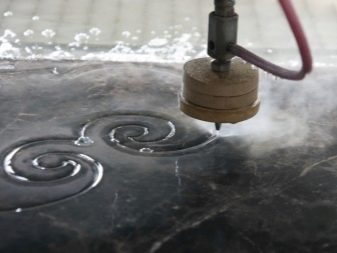
Useful Tips
Working with tiles requires some skill. To get a high-quality and beautiful cut, you should adhere to several recommendations:
- All safety precautions must be followed when using an electric tool. Handle materials carefully and slowly.
- Do not try to cut through the tile with a grinder completely in one pass. It is advisable to initially cut out a small groove, repeating this in several approaches.
- Cutting curly elements (for example, snowflakes) from ceiling and other tiles is best with a grinder, drill and other tools.


- Give preference to quality tools only. This is especially true for diamond discs and bits, which quickly fail.
- Cutting ceramic tiles can be made easier by soaking them in water for a while. This will soften its structure, which minimizes the risk of chipping.
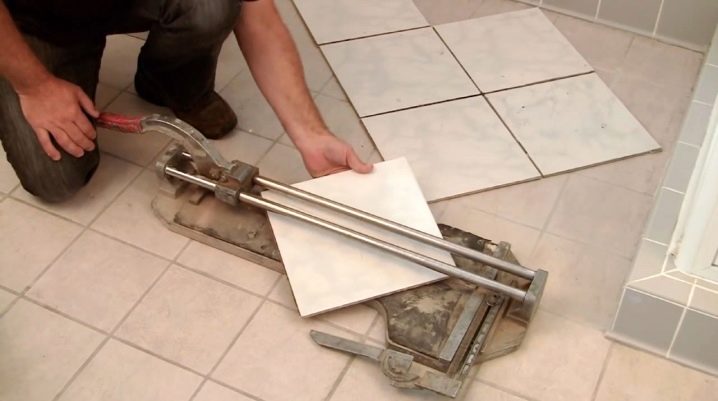
The tile cutting technology differs depending on the selected material. To simplify this process, select a quality tool that is optimal both in terms of quality and efficiency.
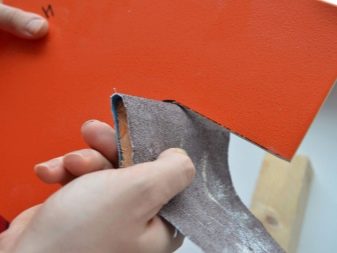
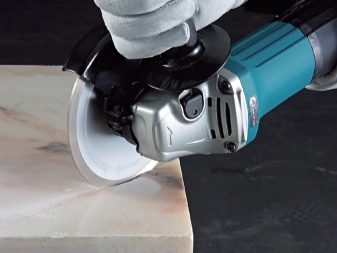
For information on how to properly cut tiles, see the next video.













The comment was sent successfully.